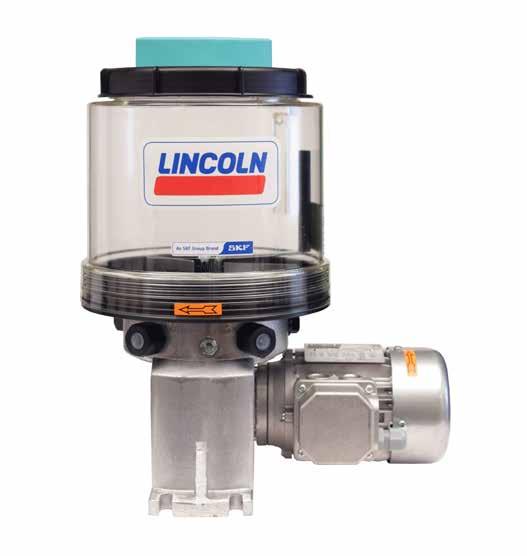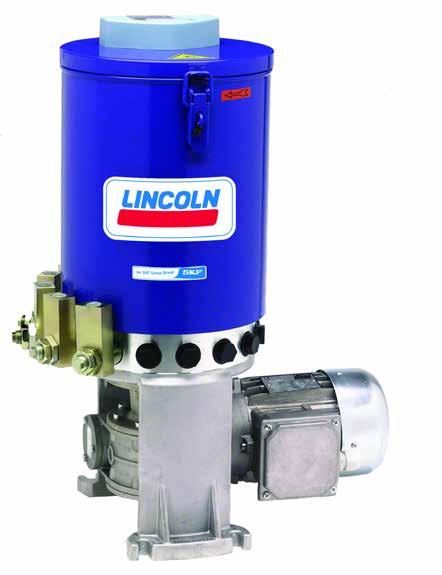
4 minute read
Lubrication systems for consistent machine operation
TRANSPORT, EQUIPMENT & LOGISTICS
LUBRICATION SYSTEMS FOR CONSISTENT MACHINE OPERATION
Advertisement
The mining environment is very harsh, with machines and equipment often being exposed to rough conditions. Lubrication systems play a critical role in reducing wear and tear on mining machinery.
P205 pump station with a 30 kg reservoir used for a new coal processing plant (Credit: Lincoln Lubrication SA) L incoln Lubrication South Africa has progressive automatic lubrication systems that are specially designed for the continual lubrication of stationary and mobile machines and systems. They help machines operate sustainably even in harsh and unforgiving environments.
“The continuous delivery of the correct amount of lubricant to the correct points at the right time offers monumental savings for end customers,” says Joe Barnard, sales consultant, Lincoln Lubrication SA. “Alongside extended machine and equipment availability and lifespan, customers will also reap the benefits of increased uptime and productivity and reduced operational costs.”
Eliminating common problems
By delivering the correct amount of lubricant, the progressive automatic lubrication system eliminates the common and costly problem of under- and overlubrication that is normally associated with inaccurate and irregular manual lubrication. Barnard explains that underlubrication can lead to component wear and tear and equipment failure, while over-lubrication is wasteful and pollutes the environment. “Furthermore, the utilisation of our lubrication systems will prevent unnecessary stoppages to perform lubrication tasks and manpower is no longer required to lubricate the points.”
A progressive automatic lubrication system consists of a pump connected to at least one primary metering device. Second-level metering devices can be connected to the outlets of the primary metering device if required, to increase the number of lubricated points, depending
on the pump’s operating pressure. The outlets of the primary and second-level metering devices are connected via branch lines to the lubrication points of the machine. The pump supplies lubricant to the metering devices with pressures of up to 550 bar, depending on the pump model. The metering devices split the lubricant into even or predefined amounts of lubricant (depending on the metering device), which are positively displaced to the lubrication points or to the inlet of a connected secondary metering device.
According to Barnard, these progressive systems can dispense a precise, metered amount of lubricant to up to 150 lubrication points over distances of approximately 15 m, depending on case values. For oil applications, even in connection with flow limiters, distances of over 100 m can be covered. Barnard goes on to explain that the progressive systems will provide continuous lubrication as long as the pump is in operation. “Once the pump stops, the pistons of the progressive metering device will stop in their current position and will carry on from there as soon as the pump starts supplying lubricant again. The progressive circuit of one outlet of the pump will stop when only one lubrication point is blocked, alerting personnel to service the system.”
Different applications
These ultrareliable, robust progressive automatic lubrication systems do not miss a beat, even in the most stringent operating conditions such as potentially high lubrication-point back pressure, low temperatures and dirty, wet or humid environments. The systems are extensively used in a wide range of small, medium and large machines and equipment. They include mobile machines (wheel loaders, excavators and trenchers), construction machines (concrete and mortar pumps), agricultural machines (harvesters, balers, manure spreaders and sugar cane loaders), wood reclaimers, materials handling machines (reach stackers and crane carts), on-road trucks (waste press) and buses.
Lincoln secured an order to supply and install 13 progressive automatic lubrication systems at a newly built coal processing plant in Mpumalanga in April 2021. “The plant is building a new conveyor belt system with take-ups, pulleys, drives, etc., which will travel from the new mining area to the old, existing plant. This is a large area that requires lubrication and we will be installing the durable, versatile and reliable P205 and P215 525v pump stations with 30 kg reservoirs to meet the application requirements,” Barnard explains.
Additional applications of these versatile lubrication systems include hydro-electric plants, asphalt mixing plants, food and beverage facilities (fillers and washing machines), quarries (screens and crushers), as well as in the oil and gas industry (reciprocating compressors).

Ideal solutions
In order to recommend the optimum lubrication solution, including the best lubricant for each individual application, trained Lincoln application engineers will first determine a number of variables such as the number of lube points, back pressures at the lube points, operating temperature range, the feed pump’s drive energy, and control and monitoring. “We prescribe different lubricants – i.e. oil, fluid grease or grease – which have different viscosities to suit each application,” says Barnard.
The different types of oils include mineral, organic and synthetic, which are classified in ISO VG viscosity classes from 2 to 3 200. NLGI grade 000, 00 and 0 greases are known as fluid greases. Greases classified as NLGI grade 1-6 are consistent lubricants, which are soft to hard, triplecomponent mixtures of a base oil as the lubricating fluid, a thickening agent and additives. “In most instances, greases of NLGI grade 1 up to 3 are suitable for use in a lubrication system but we do recommend a compatibility check prior to using any oil or grease with our lubrication systems,” advises Barnard.
P215 525v pump station with 30 kg reservoir able to meet lubrication requirements on a coal processing plant (Credit: Lincoln Lubrication SA)










